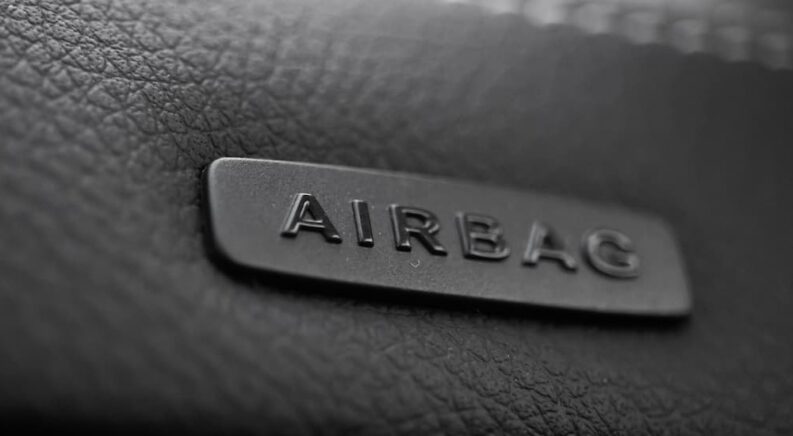From waxing the hood to deep-cleaning the wheels and giving the dash a healthy coat of Armor All, drivers tend to obsess over the smallest details. That said, there’s one common vehicle component that no driver is in a rush to get acquainted with: the airbag. This vital piece of safety equipment is the last line of defense when things go wrong, but few drivers stop to give their airbags much thought in the course of their day-to-day lives.
Airbags have saved countless lives since their introduction, allowing drivers to walk away from accidents that would have once required a lengthy hospital stay or worse. Many drivers might be surprised to learn that airbags are a fairly recent addition to our cars, trucks, and SUVs, with the safety technology only becoming federally mandated in 1998. So, what exactly are airbags? How do they work, and what should you do if they become deployed in an accident? Join us as we learn how this relatively simple piece of technology can have such a big impact on inflating our sense of safety and security behind the wheel.
The History of the Airbag
If you’ve ever been saved by an airbag, thank a dentist. The original concept behind the modern airbag can be traced back to a 1919 patent by two Alabama dentists, but their invention was more focused on the airplane industry as a way to cover planes and various automotive parts. The first airbag designed for automotive use was conceptualized decades later by either American engineer John W. Hetrick or German engineer Walter Linderer in the early 1950s. Both Hetrick and Linderer’s airbags were based on a system that would use compressed air to quickly inflate the airbags with significant bumper contact (or by the driver deploying it manually).
Unfortunately for Hetrick, there wasn’t much of a market for his new idea. The engineer was unable to attract investment for the airbag concept, with the patent languishing on the shelves until it finally expired in 1971. Much to the inventor’s chagrin, Ford would start experimenting with the airbag idea as soon after Hetrick’s patent expired, installing an early airbag system in some short-lived Ford models.
By the late 1960s, airbag technology was on its way to its final form, but there was just one problem: vehicles weren’t sophisticated enough to know when a crash was occurring. Enter Allen K. Breed, who would invent an electromagnetic sensor that could easily detect a crash. Breed used Japanese engineer Yasuzaburou Kobori’s explosive concept to inflate the airbag in less than the blink of an eye, and the modern airbag was born. Chrysler and Ford would be the first to adopt the technology, and Ford would play a big part in normalizing it, equipping a fleet of 1973 Chevy Impala models for the US government with the new airbag technology. The 1973 Oldsmobile Toronado was also the first vehicle to offer a passenger-side airbag.
Interestingly, GM quickly backtracked on its early airbag advocacy as it started lobbying against legally mandated airbags along with Ford. Those lobbyists earned their paychecks, with the government failing to pass a federal airbag mandate until 1998. That might seem alarmingly recent to some drivers, but it doesn’t mean airbags were nowhere to be found until almost the turn of the millennium. In response to consumer demands, many automakers started designing vehicles with frontal airbags in the late 1980s; it just took the government a while to catch up.
The modern airbag is made up of three parts: an impact sensor, an inflation module, and the bag itself. When the impact sensor detects a crash, the inflation module jumps into action. Different airbags use different approaches when it comes to inflation, but most vehicles rely on a chemical reaction that uses electricity to ignite an explosive compound to rapidly convert sodium azide into nitrogen gas. This reaction is fast enough to deploy an airbag at 100 to 220 mph — or about 1/20th of a second.
While it might have taken a long time to get there, there’s no denying the impact that widespread airbag adoption has had on overall automotive safety. According to a 2017 study by the National Highway Traffic Safety Administration (NHTSA), more than 50,000 lives have been saved by frontal airbags since 1977. The same study found that airbags have reduced driver fatalities by 29 percent and fatalities of front-seat occupants over the age of 12 by 32 percent.

Types of Airbags
When most drivers picture an airbag, they think of the frontal airbags that emerge from the steering wheel and dashboard for front-seat passengers. These are certainly the most prevalent type of airbag on the market — and the only ones required by law — but most of today’s vehicles tend to pack at least six airbags in total. In addition to the frontal airbags, many vehicles come standard with two side-torso impact airbags and two side-curtain airbags. Let’s take a closer look at each of these airbags to see how they compare with the standard frontal airbags and explore some less common designs that have popped up in recent years.
Side-Curtain Airbags
Designed to deploy from where a vehicle’s side windows meet the roof, side-curtain airbags essentially provide head protection on the left and right sides of the cabin. Introduced in the late 90s and gaining widespread popularity throughout the early 2000s, side-curtain airbags are now a standard feature on almost every vehicle. These airbags are largely focused on protecting the head and preventing the driver or passengers from slamming into the glass window. One study estimated that side-curtain airbags can reduce brain injury or fatalities by up to 45 percent in a side-impact scenario. A new form of side-curtain airbags known as roll-sensing curtain airbags takes the technology one step further. Common on SUVs, these airbags are designed to stay inflated for a longer period, protecting passengers in the event of a rollover crash.
Side-Torso Airbags
Side-curtain airbags are often accompanied by another type of airbag called a side-torso airbag. Focused on protecting the body from the neck down, these airbags are usually located on the door panel or even the seat itself. These airbags are essential for reducing injuries to the pelvis and lower abdomen and are also effective in preventing ejections in a rollover scenario. First debuting on the 1995 Volvo 850, side-torso airbags are now a common feature across the industry.
Center Airbag
Frontal airbags are designed to protect the front seat driver and passenger, but what about the middle seat? While this type of seat has become increasingly rare in many late-model vehicles, middle-seat passengers are just as susceptible to injuries as the driver and passenger, which is where the center airbag comes in. Deploying from the driver’s seat, these airbags aim to protect the middle-seat passenger from colliding with the dash and from the person sitting in the driver’s or passenger’s seat. Center airbags are still relatively rare but can be found on a number of Hyundai and Volkswagen models from 2019 to the present.
Rear Airbags
Given that rear-seat passengers are more likely to collide with a (relatively) soft front-row seat instead of the dashboard or windshield, rear-seat frontal airbags haven’t been a huge priority in the industry. Most vehicles come equipped with rear side-curtain airbags that protect passengers from the worst damage, but some luxury models, like the 2021 Mercedes-Benz S-Class are now equipped with rear seat airbags. The Mercedes’ airbags are also unique because they use ambient air- not a gas-powered cartridge- to inflate them, making them the first of their kind in the industry.
Knee Airbag
A lot of attention is given to protecting the head and neck in the event of a crash, but lower-body injuries can be just as devastating for those involved. Toyota was the first to experiment with knee airbags in the 2002 Caldina and has since expanded its application outside of the Japanese market with an appearance on the Toyota Avensis for European drivers. The knee airbags deploy from the steering wheel or glove compartment, reducing leg injuries and creating a safer ride for all involved.
Seatbelt Airbag
If the airbag is the last line of defense in a crash, the seat belt must be the first. While seatbelts do exactly what they’re designed to do, they’re not always gentle, which is why seatbelt airbags have become an increasingly common feature on some models. Inflating directly from the belt itself, these airbags are intended to more evenly distribute the force of the belt across the chest, which can go a long way when it comes to preventing rib or chest injuries. First debuting on the 2010 Ford Explorer, Lexus, Mercedes-Benz, and even Cessna Aircraft have deployed seatbelt airbags in the last decade.
Pedestrian Airbag
Most airbags are designed to protect the people inside a vehicle, but pedestrian airbags are focused on those outside the car, truck, or SUV. The 2012 Volvo V40 was the first model to sport the feature, which uses a sophisticated collision-detection system to deploy external airbags in the event of a crash. Typically designed to cover areas like the A-pillars and bonnet edge, these pedestrian airbags seem to work as intended, as the V40 earned the highest possible rating in a pedestrian collision test performed by EuroNCAP.

What to Do When an Airbag Deploys
If you’ve been in an accident, figuring out what to do with your airbags is probably the last thing on your mind. Between checking in with any other drivers or passengers involved in filing a report with law enforcement and contacting your insurance, the minutes, hours, and days after an accident can feel like a blur. That said, there are some airbag-related questions you’ll have to consider as you move forward.
First, no matter how minor the accident, a vehicle should never be driven if the airbags have been deployed. Waiting for a tow truck might seem like a pain after a minor fender bender, but without working airbags, even a short trip is inadvisable. Go through the regular post-accident checklist, make sure everyone is okay, and worry about the airbags once your vehicle is safely tucked away at your local auto shop.
The next step is getting the mechanic or dealership to assess the damage. If there’s been extensive damage, including any damage to the frame itself, the vehicle might be “totaled” or written off as a total loss by your insurance company. In this case, there’s no reason to mess with the airbags. Depending on your policy, your insurance company might cut you a check for a new vehicle, but regardless of what route you take, the airbags are no longer your problem.
If, on the other hand, the accident was relatively minor and there was no structural damage to the vehicle, the airbags can be replaced, and the vehicle will be as good as new. That brings us to airbag replacement. If you’re looking for a brand-new airbag, plan to spend anywhere between $1,000 to $2,000 a pop — or up to $3,000 to $5,000 depending on the severity of the crash. That’s no small chunk of change, though in most cases, it will be your insurance company that foots the bill. If you’re paying out of pocket and looking for a slightly cheaper option, airbags can often be repaired for around $1,000 per unit.
It’s hard to regularly inspect an airbag for damage or perform a test to make sure it’s in good working order, so what’s a driver to do? Most vehicles come equipped with a diagnostic system for the airbag, which usually comes in the form of an illuminated Supplemental Restraint System (SRS) light on your dashboard. If this light comes on, the issue should be addressed as soon as possible, as it could indicate an airbag that’s not fit for service.
One of the Most Important Safety Features in Your Car
Airbags are something drivers rarely think about, but that obliviousness rarely lasts past the moment of impact. There’s really no underselling the importance of this crucial safety system, a fact that’s backed up by some of the compelling crash fatality data we reviewed earlier. Every time you step behind the wheel, take a moment to thank Parrot, Round, Hetrick, Linderer, Kobori, Breed, and all the other unsung inventors and engineers who were well ahead of their time when it came to building a better and safer vehicle.

